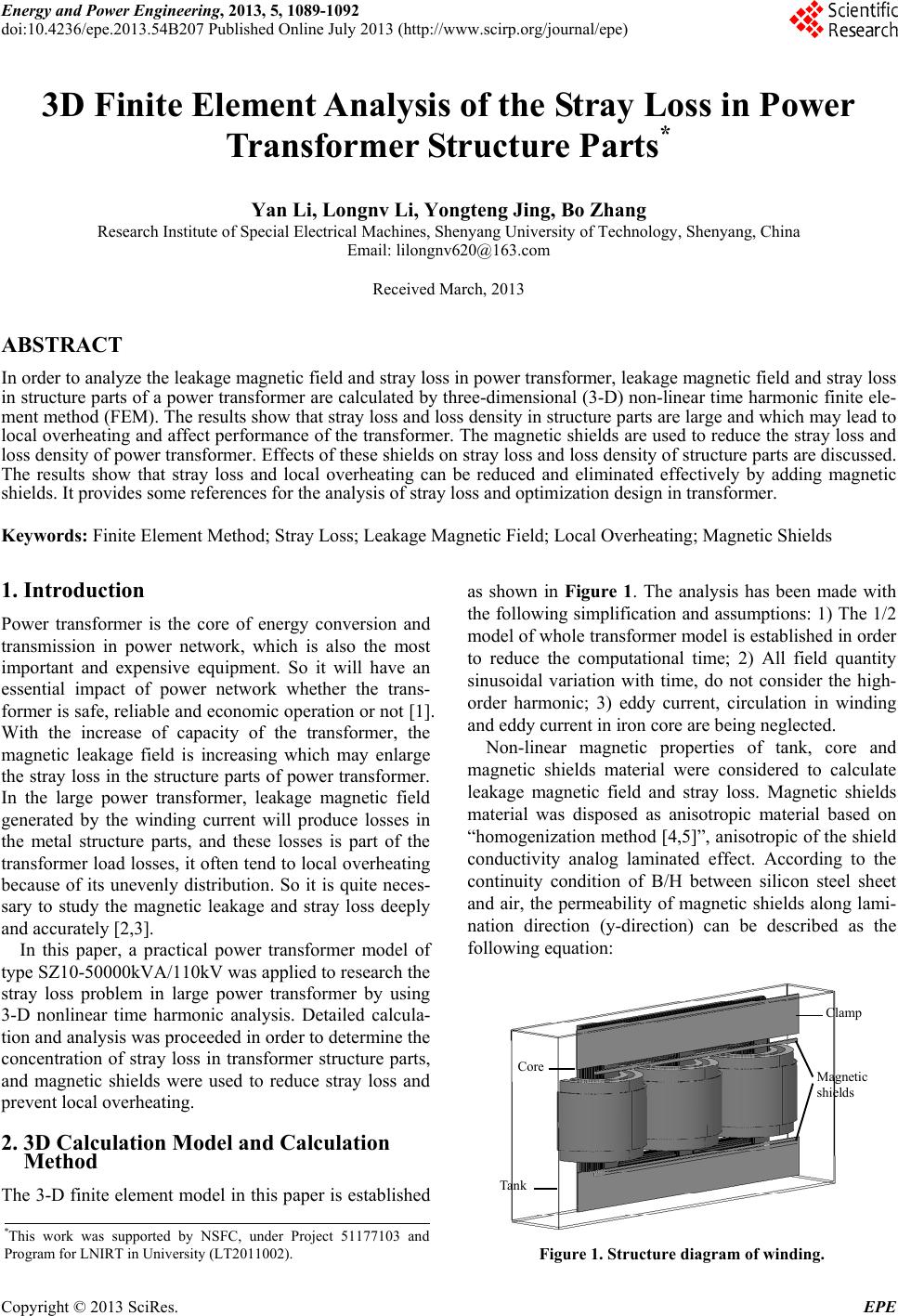
Energy and Power Engineering, 2013, 5, 1089-1092
doi:10.4236/epe.2013.54B207 Published Online July 2013 (http://www.scirp.org/journal/epe)
3D Finite Element Analysis of the Stray Loss in Power
Transformer Structure Parts*
Yan Li, Longnv Li, Yongteng Jing, Bo Zhang
Research Institute of Special Electrical Machines, Shenyang University of Technology, Shenyang, China
Email: lilongnv620@163.com
Received March, 2013
ABSTRACT
In order to analyze the leakage magnetic field and stray loss in power transformer, leakage magnetic field and stray loss
in structure parts of a power transformer are calculated by three-dimensional (3-D) non-linear time harmonic finite ele-
ment method (FEM). The results show th at stray loss and loss density in structure parts are large an d which may lead to
local overheating and affect performance of the transformer. The magnetic shields are used to reduce the stray loss and
loss density of power transformer. Effects of these shields on stray loss and loss density of structure parts are discussed.
The results show that stray loss and local overheating can be reduced and eliminated effectively by adding magnetic
shields. It provides some references for the analysis of stray loss and optimization design in transformer.
Keywords: Finite Element Method; Stray Loss; Leakage Magnetic Field; Local Overheating; Magnetic Sh ields
1. Introduction
Power transformer is the core of energy conversion and
transmission in power network, which is also the most
important and expensive equipment. So it will have an
essential impact of power network whether the trans-
former is safe, reliable and economic operation or not [1].
With the increase of capacity of the transformer, the
magnetic leakage field is increasing which may enlarge
the stray loss in the structure parts of power transformer.
In the large power transformer, leakage magnetic field
generated by the winding current will produce losses in
the metal structure parts, and these losses is part of the
transformer load losses, it often tend to local overheating
because of its unevenly distribution. So it is quite neces-
sary to study the magnetic leakage and stray loss deeply
and accurately [2,3].
In this paper, a practical power transformer model of
type SZ10-5000 0kVA/110k V was app lied to research the
stray loss problem in large power transformer by using
3-D nonlinear time harmonic analysis. Detailed calcula-
tion and analysis was proceeded in order to determine the
concentration of stray loss in transformer structure parts,
and magnetic shields were used to reduce stray loss and
prevent local overheating.
2. 3D Calculation Model and Calculation
Method
The 3-D finite element model in this paper is established
as shown in Figure 1. The analysis has been made with
the following simplification and assumptions: 1) The 1/2
model of whole transformer model is established in order
to reduce the computational time; 2) All field quantity
sinusoidal variation with time, do not consider the high-
order harmonic; 3) eddy current, circulation in winding
and eddy current in iron core are being neglected.
Non-linear magnetic properties of tank, core and
magnetic shields material were considered to calculate
leakage magnetic field and stray loss. Magnetic shields
material was disposed as anisotropic material based on
“homogenization method [4,5]”, anisotropic of the shield
conductivity analog laminated effect. According to the
continuity condition of B/H between silicon steel sheet
and air, the permeability of magnetic shields along lami-
nation direction (y-direction) can be described as the
following equation:
Core
Tank
Clamp
Magnetic
shields
*This work was supported by NSFC, under Project 51177103 and
Program for LNIRT in University (LT2011002). Figure 1. Structure diagram of winding.
Copyright © 2013 SciRes. EPE